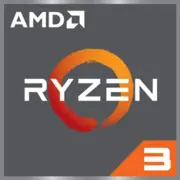AMD Ryzen 3 3200G

AMD Ryzen 3 3200G: Budget Processor with Integrated Graphics in 2025
Updated: April 2025
1. Key Specifications: Architecture and Performance
The AMD Ryzen 3 3200G processor, released in 2019, remains a popular choice for budget PCs due to its favorable combination of price and capabilities.
Architecture and Process Technology
- Codename: Picasso.
- Architecture: Zen+ (optimized version of the original Zen).
- Process Technology: 12 nm (GlobalFoundries).
- Cores/Threads: 4/4.
- Frequencies: Base — 3.6 GHz, turbo mode — up to 4 GHz.
- Cache: L3 — 4 MB.
- TDP: 65 W.
Key Features:
- Integrated Vega 8 Graphics (8 cores, frequency up to 1250 MHz) — allows for gaming on low settings without a discrete graphics card.
- Unlocked Multiplier — supports overclocking (requires a motherboard with B450/X470 chipset and adequate cooling).
- AMD SenseMI Technologies — optimization of power consumption and performance.
Performance:
- Geekbench 6 (2025): 1106 (Single-Core), 3049 (Multi-Core).
- Practical Examples:
- Office Tasks (Chrome, Excel, Zoom) — runs without delays.
- Light Gaming: CS:GO — 60-70 FPS on medium settings (1080p), GTA V — 40-50 FPS (low settings).
- Video Editing: Basic rendering in DaVinci Resolve is possible, but patience is required for 4K.
2. Compatible Motherboards
Socket and Chipsets
- Socket: AM4 — a universal AMD platform that supports multiple generations of processors.
- Recommended Chipsets:
- A320 — basic option (no overclocking, suitable for office PCs). Example: ASUS Prime A320M-K ($60-70).
- B450 — optimal choice (overclocking support, PCIe 3.0). Example: MSI B450 Tomahawk Max ($90-110).
- X470 — for enthusiasts (improved power delivery, more ports).
Selection Features:
- BIOS Update: Some motherboards require a firmware update to work with Ryzen 3000. Verify the BIOS version with the seller.
- Form Factor: Micro-ATX models are suitable for compact builds (for example, Gigabyte B450M DS3H).
3. Supported Memory
- Memory Type: DDR4 (DDR5 not supported).
- Frequencies: Up to 2933 MHz (officially), but many motherboards allow overclocking to 3200 MHz.
- Recommendations:
- Use dual-channel mode (2×8 GB instead of 1×16 GB) to enhance Vega 8 performance.
- Example: Kingston HyperX Fury 16 GB (2×8 GB) DDR4-3200 — $50-60.
Important: Memory with low timings (CL16) will improve system responsiveness.
4. Power Supply: How to Avoid Mistakes
- Power: For a system with Ryzen 3 3200G without a discrete graphics card, a PSU of 400-450 W will suffice (for example, EVGA 450 BR, $40-45).
- With Graphics Card: If you plan to add a GPU like the NVIDIA GTX 1650, choose a PSU of 500 W (Corsair CX550M, $60).
- Certification: 80+ Bronze is the optimal choice for reliability.
Tip: Do not skimp on the PSU — poor-quality models can damage components.
5. Pros and Cons
Advantages:
- Price: In 2025, the processor costs $80-90 (new), which is cheaper than many competitors.
- Energy Efficiency: TDP 65 W — low heat output, suitable for compact cases.
- Vega 8 Graphics: Better than Intel UHD 630 in the same segment.
Disadvantages:
- 4 Threads: Multitasking is limited (for example, game streaming is almost impossible).
- No PCIe 4.0: New generation discrete graphics cards won't fully utilize their potential.
- Outdated Process Technology: 12 nm compared to 7 nm in Ryzen 5000/7000.
6. Use Cases
Gaming:
- eSports: Dota 2, Rocket League, Overwatch 2 — 60+ FPS on low settings.
- AAA Titles: Cyberpunk 2077 — 25-30 FPS (720p, low settings).
Work Tasks:
- Office Applications: Ideal for Word, Excel, browsers.
- Programming: Handles Visual Studio Code well, but heavy IDEs (like Android Studio) may lag.
Multimedia:
- Streaming video (4K via YouTube) — no issues.
- Basic editing in Premiere Pro — possible, but rendering will take time.
7. Comparison with Competitors
AMD Ryzen 5 3400G ($120-130):
- Pros: 4 cores/8 threads, Vega 11.
- Cons: Higher price.
Intel Core i3-10100 ($100-110):
- Pros: Better single-threaded performance.
- Cons: UHD 630 graphics is weaker than Vega 8.
Conclusion: Ryzen 3 3200G excels in the budget segment due to its graphics.
8. Practical Assembly Tips
1. Case: Choose models with good ventilation (Deepcool MATREXX 30, $35).
2. Cooling: The stock cooler is sufficient, but for overclocking, consider Deepcool Gammaxx 400 ($20).
3. Storage: An SSD is essential! Kingston A400 480 GB — $35.
4. Upgrade: In the future, you can install a Ryzen 5 5600 (after a BIOS update).
9. Final Verdict: Who is the Ryzen 3 3200G Suitable For?
This processor is an ideal choice for:
- Budget PCs: Office work, study, browsing.
- Media Centers: 4K viewing, light gaming.
- Beginner Builders: Low price and ease of installation.
Why in 2025? Despite its age, the Ryzen 3 3200G remains relevant due to its availability and integrated graphics. If you need a PC "here and now" for $300-400 — this is your option. For demanding tasks, consider upgrading to the Ryzen 5 7600G or Intel Core i5-13400.
Basic
CPU Specifications
Memory Specifications
GPU Specifications
Miscellaneous
Benchmarks
Compared to Other CPU
Share in social media
Or Link To Us
<a href="https://cputronic.com/en/cpu/amd-ryzen-3-3200g" target="_blank">AMD Ryzen 3 3200G</a>